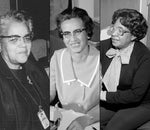Cotton Blocks
Hidden Figures
Genuine Ghanaian Ankara Fabric
Double Layer
100% Cotton
Multi w/Shimmering Gold
Made in Cleveland, OH
This print has a large motif (14+inches) therefore the entire motif cannot be guaranteed to appear on the mask, the mask pattern is aprox 8in. The beautiful expression of the print will be visible on the mask as shown in pictures.
Cotton Blocks' Buy One Give One Initiative!
For every mask you purchase, we will donate a mask to folks who need them.
We will keep this going until we no longer need to wear them.
Mathematician Mary Jackson was one of a small group of African American women who worked as aeronautical engineers, called "human computers," at NASA during the Space Age.
Mary Jackson (1921-2005)
Mathematician Mary Winston Jackson excelled academically in a time of racial segregation. Her math and science skills earned her a position as a "human computer" for NACA, and she later became NASA's first Black female engineer. Along with serving a vital role in the development of the space program, she helped other women and minorities advance their careers. Jackson died in February 2005 at the age of 83. The story of her groundbreaking contributions to NASA was later dramatized in the 2016 film Hidden Figures.
Early Years
Mary Winston Jackson was born on April 9, 1921, in Hampton, Virginia, the daughter of Ella and Frank Winston. She attended Hampton’s all-Black schools and graduated with high honors from George P. Phenix Training School in 1937. Five years later, she earned dual bachelor’s degrees in mathematics and physical science from Hampton Institute.
Taking her Talents to Work
After college, Jackson took on a series of jobs, including teacher, bookkeeper and receptionist. Then in 1951, she found employment at the National Advisory Committee for Aeronautics (NACA, the predecessor agency to NASA) in Langley, Virginia. She worked at the West Computers section as a research mathematician—known at the time as a "human computer." In 1953, she moved to the Compressibility Research Division of NACA.
Working through Segregation
Though President Franklin D. Roosevelt’s Executive Order 8802 prohibited discrimination in the defense industry, Virginia state law still enforced segregation in the workplace. All work facilities had separate restrooms and cafeterias designated “white” or “colored.” In the company cafeteria, whites could select their food choices and sit in a lunchroom. Black people had to make their food requests to a cafeteria attendant and then go back to their desks and eat, an experience Jackson considered an indignity.
NASA's First Black Female Engineer
After several months of “separate and unequal” accommodations, Jackson had had enough. She considered resigning, but a chance encounter with a supervisor changed her mind. After hearing her complaints, he invited her to work for him and she accepted. He quickly saw her potential and encouraged her to take engineering classes. In time, she was promoted to aeronautical engineer, making her NASA's first Black female engineer, and developed expertise working with wind tunnels and analyzing data on aircraft flight experiments.
Giving Back by Helping Others
By 1978, Jackson changed positions to be a human resources administrator. She served as both the Federal Women’s Program Manager in the Office of Equal Opportunity Programs and as the Affirmative Action Program Manager. From then until her retirement in 1985, she helped other women and minorities advance their careers, advising them to study and take extra courses to increase their chances for promotion.
Death and 'Hidden Figures' Legacy
During her career, Jackson served on many organizations’ boards and committees, including the Girl Scouts of America, and was honored by numerous charitable organizations for her leadership and service. She died at age 83 on February 11, 2005, at Riverside Convalescent Home in Hampton, Virginia.
In 2016, the story of Jackson and her NASA colleagues Katherine G. Johnson and Dorothy Johnson Vaughan, who calculated flight trajectories for project Mercury and the Apollo program in the 1960s, made it to the big screen in Hidden Figures. Janelle Monáe portrays Jackson in the film.
In 2018, it was announced that Jackson Elementary in Salt Lake City, Utah, named for President Andrew Jackson, would be renamed Mary W. Jackson Elementary School in honor of the groundbreaking NASA engineer.
In June 2020, NASA renamed its DC headquarters after Jackson to The Mary W. Jackson NASA Headquarters.
Article Title ~Mary Jackson Biography
Author ~Biography.com
https://www.biography.com/scientist/mary-winston-jackson
One of NASA's human 'computers,' Katherine Johnson performed the complex calculations that enabled humans to successfully achieve space flight. Her story is depicted in the 2016 movie 'Hidden Figures.'
Katherine Johnson (1918-2020)
Katherine Johnson made the most of limited educational opportunities for African Americans, graduating from college at age 18. She began working in aeronautics as a "computer" in 1952, and after the formation of NASA, she performed the calculations that sent astronauts into orbit in the early 1960s and to the moon in 1969. Johnson was honored with the Presidential Medal of Freedom in 2015 and saw her story brought to light through a book and a feature film the following year. She passed away on February 24, 2020, at the age of 101.
Early Years and Education
Johnson was born Katherine Coleman on August 26, 1918, in White Sulphur Springs, West Virginia. A bright child with a gift for numbers, she breezed through her classes and completed the eighth grade by age 10. Although her town didn’t offer classes for African Americans after that point, her father, Joshua, drove the family 120 miles to Institute, West Virginia, where they lived while she attended high school.
Johnson enrolled at West Virginia State College (now West Virginia State University) in Institute, West Virginia, where she encountered a hands-on faculty. One particularly engaged professor was Dr. William W. Schieffelin Claytor, the third African American to earn a Ph.D. in mathematics, who was determined to prepare Johnson to become a research mathematician. At age 18, she graduated summa cum laude with degrees in mathematics and French.
The following year, Johnson became one of three students to desegregate West Virginia University's graduate school in Morgantown. However, she found the environment less welcoming than it had been in Institute, and never completed her program there.
The 'Computer'
Beginning in the late 1930s, Johnson taught math and French at schools in Virginia and West Virginia.
In 1952, Johnson learned that the National Advisory Committee for Aeronautics (NACA) was hiring African American women to serve as "computers;" namely, people who performed and checked calculations for technological developments. Johnson applied, and the following year she was accepted for a position at Langley Research Center in Hampton, Virginia.
Johnson not only proved adept at her calculations, she displayed a curiosity and assertiveness that caught her superiors by surprise. "The women did what they were told to do,” she recalled. “They didn’t ask questions or take the task any further. I asked questions; I wanted to know why."
After only two weeks, Johnson was transferred from the African American computing pool to Langley's flight research division, where she talked her way into meetings and earned additional responsibilities. She achieved success despite difficulties at home: In 1956, her husband died of a brain tumor.
NASA Pioneer
In 1958, after NACA was reformulated into the National Aeronautics and Space Administration (NASA), Johnson was among the people charged with determining how to get a human into space and back. The following year she remarried, to decorated Navy and Army officer James A. Johnson.
For Johnson, calculating space flight came down to the basics of geometry: "The early trajectory was a parabola, and it was easy to predict where it would be at any point," she said. "Early on, when they said they wanted the capsule to come down at a certain place, they were trying to compute when it should start. I said, 'Let me do it. You tell me when you want it and where you want it to land, and I'll do it backwards and tell you when to take off .' " As a result, the task of plotting the path for Alan Shepard's 1961 journey to space, the first in American history, fell on her shoulders.
The next challenge was to send a man in orbit around Earth. This involved far more difficult calculations, to account for the gravitational pulls of celestial bodies, and by then NASA had begun using electronic computers. Yet, the job wasn't considered complete until Johnson was summoned to check the work of the machines, providing the go-ahead to propel John Glenn into successful orbit in 1962.
While the work of electronic computers took on increased importance at NASA, Johnson remained highly valuable for her unwavering accuracy. She performed calculations for the historic 1969 Apollo 11 trip to the moon, and the following year, when Apollo 13 experienced a malfunction in space, her contributions to contingency procedures helped ensure its safe return.
Johnson continued to serve as a key asset for NASA, helping to develop its Space Shuttle program and Earth Resources Satellite, until her retirement in 1986.
'Hidden Figures'
Margot Lee Shetterly's 2016 book Hidden Figures: The American Dream and the Untold Story of the Black Women Who Helped Win the Space Race celebrated the little-known story of Johnson and her fellow African American computers. It was also turned into an Oscar-nominated feature film, Hidden Figures (2016), starring actress Taraji P. Henson as Johnson.
Awards and Legacy
Johnson was honored with an array of awards for her groundbreaking work. Among them are the 1967 NASA Lunar Orbiter Spacecraft and Operations team award, and the National Technical Association’s designation as its 1997 Mathematician of the Year. Additionally, she earned honorary degrees from SUNY Farmingdale, Maryland's Capitol College, Virginia's Old Dominion University and West Virginia University.
In November 2015, President Barack Obama presented Johnson with the Presidential Medal of Freedom. Margot Lee Shetterly's 2016 book Hidden Figures: The American Dream and the Untold Story of the Black Women Who Helped Win the Space Race celebrated the little-known story of Johnson and her fellow African American computers. It was also turned into an Oscar-nominated feature film, Hidden Figures (2016), starring actress Taraji P. Henson as Johnson.
A year later, in September 2017, 99-year-old Johnson was honored by NASA, with the dedication of a new research building which is named after her — the Katherine G. Johnson Computational Research Facility. Johnson, her family and friends were at the ribbon-cutting ceremony for the new building which is part of NASA's Langley Research Center in Hampton, Virginia.
“We’re here to honor the legacy of one of the most admired and inspirational people ever associated with NASA,” Langley Director David Bowles said in a press release. “I can’t imagine a better tribute to Mrs. Johnson’s character and accomplishments than this building that will bear her name.”
Johnson's humble response to a building named after her was said with a laugh: “You want my honest answer? I think they’re crazy.”
Her trailblazing contributions were celebrated at the dedication ceremony where Margot Lee Shetterly, the author of Hidden Figures and keynote speaker, said of the "human computers": “We are living in a present that they willed into existence with their pencils, their slide rules, their mechanical calculating machines — and, of course, their brilliant minds."
She said to Johnson: "Your work changed our history and your history has changed our future."
When asked to give her advice to NASA employees who will follow in her footsteps and work in the new building named after her, Johnson simply said: “Like what you do and then you will do your best.”
Spouse and Children
In 1939, Johnson married James Francis Goble, with whom she had three daughters: Joylette, Katherine and Constance.
Death
Johnson passed away on February 24, 2020. She was 101 years old.
Article Title ~Katherine Johnson Biography
Author ~Biography.com
https://www.biography.com/scientist/katherine-g-johnson
Dorothy Johnson Vaughan worked as a mathematician on the SCOUT Launch Vehicle Program that sent America’s first satellites into space.
Dorothy Johnson Vaughan (1910-2008)
Dorothy Johnson Vaughan was an African American mathematics teacher who became one of the leading mathematical engineers in early days of the aerospace industry. After the U.S. defense industry desegregated, Vaughan worked with leading computer operators and engineers, becoming an expert in the FORTRAN programming coding language at NASA. She worked on the SCOUT Launch Vehicle Program that shot satellites into space. Vaughan and other female African American mathematicians are the subject of a 2016 film Hidden Figures.
Early Life
Dorothy Johnson was born in Kansas City, Missouri on September 20, 1910. At age seven, her parents, Leonard and Anne Johnson, moved the family to Morgantown, West Virginia. She graduated from Beechurst High School in 1925, and four years later, received a Bachelor of Science degree from Wilberforce University in Ohio. In 1932, she married Howard Vaughan.
Career in Mathematics
For the next eleven years, Vaughan divided her time between being a homemaker and a mathematics teacher at Robert Russa Moton High School in Farmville, Virginia. In 1943, the family moved to Newport News, Virginia, and Vaughan was employed as a mathematician at the National Advisory Committee for Aeronautics (the predecessor agency to NASA) in what she thought would be a temporary job. A beneficiary of President Franklin D. Roosevelt’s Executive Order 8802, Vaughan was among the first group of African Americans to be hired as mathematicians and scientists. The executive order prohibited discrimination based on race, religion and ethnicity in the defense industry.
Working Under Segregated Conditions
However, even with the executive order, state and local laws required "colored" mathematicians to work separately from their white female counterparts. Vaughan was assigned to the segregated “West Area Computing” unit, where she was required to use separate dining and restroom facilities. At NACA, she was responsible for calculating mathematical computations for engineers conducting aeronautical experiments in wind tunnels on the variables affecting drag and lift of aircraft.
In 1949, Vaughan became the first Black supervisor at NACA when she was promoted to manager of the West Area Computers. This workgroup was composed entirely of African American female mathematicians. The title gave her rare visibility and she collaborated with other well-known computer operators on various projects. She also became a dedicated advocate for female employees who deserved promotions or raises, often supporting white women as well.
Work with NASA and the Space Program
Vaughan led the West Area Computing program for a decade. Then in 1958, as NACA was transitioning into the National Aeronautics and Space Administration (NASA), the agency abolished the segregated working environment. Vaughan joined the new Analysis and Computation Division, becoming an expert FORTRAN programmer, and worked on the SCOUT (Solid Controlled Orbital Utility Test) Launch Vehicle Program, one of the nation's most successful and reliable launch vehicles, used for launching a 385-pound satellite into a 500-mile orbit.
Later Life
Vaughan sought but never received another management position at NASA. She retired in 1971. During the final decade of her career, Vaughan worked closely with fellow NASA mathematicians Katherine G. Johnson and Mary Jackson on the launch of astronaut John Glenn into orbit, which brought confidence back to America’s space program. Vaughan died on November 10, 2008. Her legacy and the story of the other women of West Computing lives on in the 2016 film Hidden Figures.
Article Title ~Dorothy Johnson Vaughan Biography
Author ~Biography.com Editors
https://www.biography.com/scientist/dorothy-johnson-vaughan













